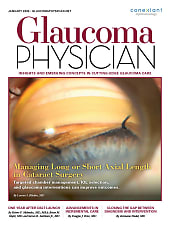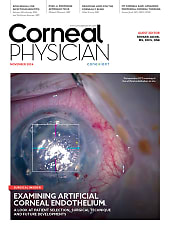
Carl Danzig, MD, director of vitreoretinal services at Rand Eye Institute in Deerfield Beach, Florida, recently presented findings from a post hoc analysis of patient data from the GATHER1 and GATHER2 clinical trials for avacincaptad pegol (ACP; Iveric Bio) at the annual Association for Research in Vision and Ophthalmology (ARVO) meeting. ACP, a novel complement component 5 (C5) protein inhibitor, is an investigational drug for treatment of geographic atrophy (GA) secondary to age-related macular degeneration (AMD). ACP is currently under US Food and Drug Administration (FDA) review, with a Prescription Drug User Fee Act goal date of August 19, 2023. The data from the post hoc analysis suggest that among patients treated with ACP, the reduction in GA growth resulted in an overall lower rate of vision loss.
Dr. Danzig recently spoke with New Retinal Physician about the phase 3 GATHER1 and GATHER2 clinical trials, implications of the post hoc analysis, and the future of GA treatment. The conversation that follows has been edited for length and clarity.
NRP: What did you find in your exploratory analysis of the GATHER1 and GATHER2 data?
Dr. Danzig: This is a very exciting time in retina, and geographic atrophy is becoming a hot topic. Both the GATHER1 and GATHER2 trials met their primary endpoints, with separation early between the sham and the ACP treatment arms. That separation expands over time, which is a promising sign for the treatment.
What we showed in our study was that, for the first time ever, we can show a link between GA progression and worsening vision. We found that a smaller percentage of patients receiving 2 mg injections of ACP experienced a greater than 10, 15, or 20 letter loss in best-corrected visual acuity (BCVA) at the 12-month time point in comparison to sham. Furthermore, we saw that there’s a 56% risk reduction in persistent vision loss in the treatment arm vs sham at 12 months.
Also, if you looked at the patients who didn’t have vision loss, the GA growth in the sham patients was about 2.5 mm2 vs 2.1 mm2 in the treatment arms. But, if you look at the patients who had vision loss, GA growth was worse in the sham arm. In the ACP arm, if the patient had vision loss, they had a much slower and smaller progression of GA compared to the sham arm. It’s early, but I thought that was very interesting. I think it’s exciting to be able to present early signals and hopefully we’ll be able to confirm these findings in the very near future.
NRP: What do these findings mean for patients with geographic atrophy?
Dr. Danzig: One thing the results mean for patients is that they provide a concrete talking point on why getting treatment early is so beneficial to prevent persistent vision loss.
When we define persistent vision loss, that means 15-letter losers for 2 consecutive visits. It wasn’t that these patients had a transient drop in visual acuity or that there was a measurement error—15 letters of loss represents meaningful vision loss. Knowing that we can reduce this vision loss risk by 56% with treatment is important. We also did multiple sensitivity analyses, where we looked at 10-letter loss and 20-letter loss, and the trend was consistent that patients who received treatment with ACP had a decreased risk of persistent vision loss at 12 months.

NRP: Were there any safety concerns related to the GATHER data?
Dr. Danzig: There were no cases of occlusive vasculitis in the treatment arms. There were no cases of retinitis. At 1 year, there were no cases of ischemic optic neuropathy. There was 1 case of mild inflammation in GATHER1, and that was observed—not treated—and it resolved on its own without any decrease in vision. Also, there were no cases of endophthalmitis. So ACP was found to be quite safe and we’re excited about having a product out there that can safely slow the rate of GA growth and reduce the risk of persistent vision loss.
NRP: Avacincaptad pegol affects the complement system, which regulates inflammation in the body. How do you explain to patients the way ACP works to protect their vision?
Dr. Danzig: There are three different pathways of complement activation: classical, alternative, and lectin. ACP is a pegylated RNA aptamer that targets C5, the most terminal complement inhibitor of the alternative pathway. We’re targeting C5 to prevent formation of the membrane attack complex, which destroys cells and produces apoptosis.
From a patient standpoint, the way that ACP works can be very hard to explain. It’s often difficult for patients to understand any explanation other than, “We’re targeting the chemicals in the body that produce inflammation that destroys your retina.” That’s generally all I say.
NRP: ACP is currently under FDA review, so it seems likely that this therapy may soon be available for GA. What does the future hold for treatment of GA and AMD?
Dr. Danzig: The GATHER2 results validate the complement pathway for treating these diseases, because it’s not just Iveric that’s trying this approach. Apellis is targeting complement component 3, Alexion is targeting complement factor D, and Gyroscope is targeting complement by upregulating complement factor I through subretinal gene therapy.
In the future, we will continue to identify the high-risk features that lead to macular degeneration and geographic atrophy and find ways to slow those processes down before AMD and GA can develop. There are discussions about potential approaches across many companies. It’s fascinating, and my hope is that 10 years from now we’ll have something even better. NRP








